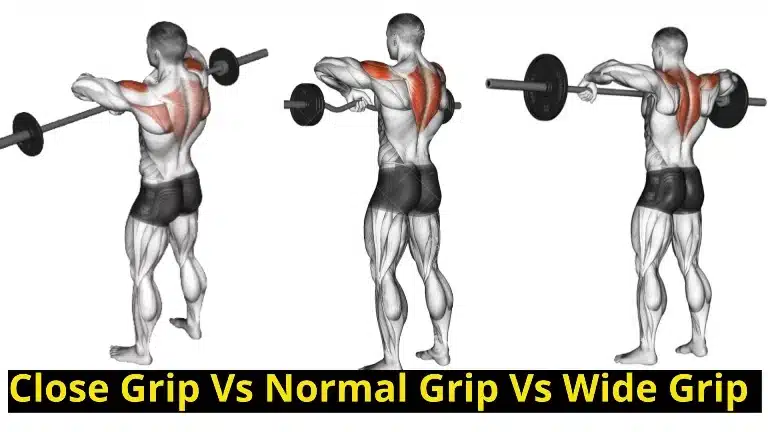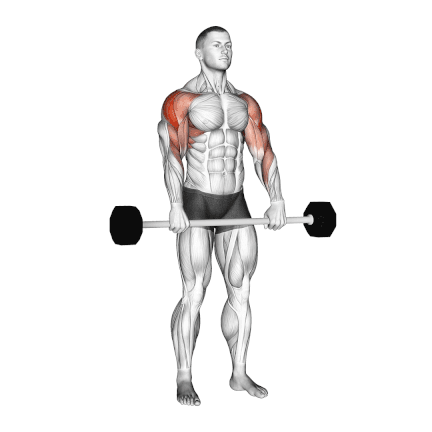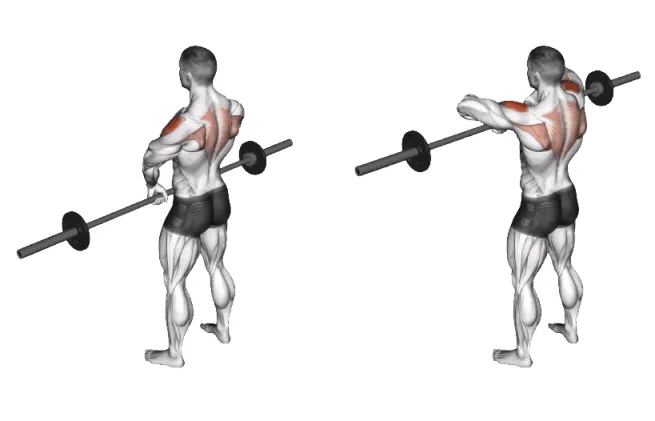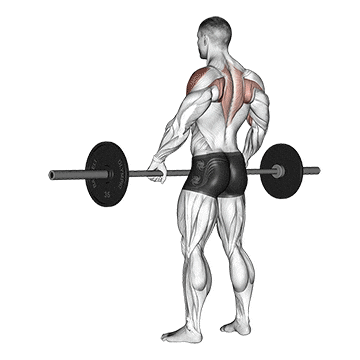Upright rows are good for building impressive shoulders and a powerful upper back. But let’s be honest: this exercise is also controversial.
There are different grips for an upright row—narrow, normal, and wide—and it can be difficult to know which one to use.
That’s where this guide comes in. We’re breaking down the narrow vs. wide grip debate, giving you the inside on which grip does what, and showing you how to do upright rows right (so you get the gains without the strain).
By the end of this guide, you’ll know which grip works best for specific muscle groups and how to do the exercise safely and effectively.

- Wide Grip Vs. Narrow Grip Vs Close Grip Upright Row
- 1. Normal (Shoulder Width) Upright Row
- 2. Close Grip Barbell Upright Row
- 3. Wide Grip Barbell Upright Row
- Tips for Improving Your Upright Row Form
- FAQs
- Can upright rows be modified for those with limited shoulder mobility?
- Are wide-grip upright rows safe?
- Which grip is best for an upright row?
Wide Grip Vs. Narrow Grip Vs Close Grip Upright Row
When performed correctly, the barbell upright row can be a fantastic muscle-building exercise for the upper back and shoulders, helping to shape the upper arms and torso.
There are three main variations of grip width: close grip, normal grip, and wide grip.
- A close or narrow grip (half of the shoulder width),
- A standard grip (shoulder-width grip)
- A wide grip (wider than the shoulder)
All have their unique advantages and disadvantages. Let’s take a closer look at each of these variations:
1. Normal (Shoulder Width) Upright Row
The normal grip variation is characterized by placing the hands slightly wider than shoulder-width apart.
This grip width provides a balanced activation of the shoulder muscles, including the deltoids, trapezius, and biceps.
It allows for a greater range of motion than the close grip and is generally considered to be a safer option for most individuals. It gives balanced muscle activation.
The normal grip variation provides overall shoulder development and suits those seeking balanced muscle activation.

How To Do
- Stand facing the barbell with your feet shoulder-width apart and load it with the weight you want to use.
- To grasp the barbell, hold it with an overhand grip and hands that are slightly closer than shoulder-width apart.
- Pick up the bar with your back straight and bend your knees.
- Keep your back straight and eyes facing forward, and lift the bar straight up while keeping it as close to your body as possible.
- Hold for a moment before you go back to the starting position.
2. Close Grip Barbell Upright Row
The close grip variation involves placing the hands closer together, typically around shoulder-width apart or slightly narrower.
The close grip upright row allows maximum (Range of motion) ROM because it allows the elbows to raise higher than the shoulders.
With a narrow grip, your upper arms draw more forward rather than moving directly out to your sides. This variation places more emphasis on the upper trap and a little less on the lateral delt and rear delt.
For some people, a closer grip may be more comfortable. However, people with shoulder pain should avoid the narrow grip variation. It puts more strain on the wrists and elbows, and it’s also harder to lift heavier weights.

How To Do
- Hold a barbell with an overhand grip and stand with your feet hip-width apart.
- Your grip on the barbell should be less than shoulder-width apart. Let it hang in front of you.
- While keeping your barbell close to your body, lift the bar and get it up to chest height using your arms.
- Allow your shoulder blades to move naturally with your shoulder joints. Pause at the top of the movement.
- Now, slowly lower the bar until it returns to its starting position.
- Repeat the close grip upright row for your desired number of repetitions.
3. Wide Grip Barbell Upright Row
The wide grip variation involves placing the hands wider than shoulder-width apart.
The wide-grip upright row is preferable to the regular upright row because it prevents the elbows from going too high, which in turn prevents rotator cuff injuries.
It may also be more shoulder-friendly for people who cannot handle the close-grip version.
The wide-grip upright row places heavy emphasis more in the lateral and rear deltoid and little lessor on the upper and middle trap because your upper arms move directly out to your sides in the same plane as lateral raises. It also allows you to lift heavier weights.
Keep in mind that heavy lift and improper foam are equal to a higher risk of shoulder impingement
Many trainers recommend that you avoid the narrow grip upright row. They say that the wide-grip upright row is safe if performed in the way described.

How To Do
- Hold a barbell with an overhand grip and stand with your feet hip-width apart.
- Your grip on the barbell should be wider than shoulder-width apart. Let it hang in front of you.
- While keeping your barbell close to your body, lift the bar and get it up to chest height using your arms.
- Allow your shoulder blades to move naturally with your shoulder joints. Pause at the top of the movement.
- Now, lower the bar under controlled motion until it returns to its starting position.
- Repeat the wide-grip upright row for your desired number of repetitions.
Read More To Learn More: Upright Row: Muscle Worked, Form, Benefits, Variations
Tips for Improving Your Upright Row Form
If you’re looking to improve your upright row form and get the most out of this exercise, here are a few tips to keep in mind:
- If you’re new to upright rows or trying to improve your form, start with a lighter weight and focus on getting the movement right before increasing the weight.
- Ensure you use the correct grip for your goals and personal preferences.
- As you lift, focus on leading with your elbows, keeping them close to your body. Think about pulling your elbows up and out.
- Don’t raise the bar higher than your shoulders. Going too high puts unnecessary stress on your shoulder joints and increases the risk of impingement.
- Keep your core engaged to help you maintain proper form and avoid using your lower back to lift the weight.
- Seeing yourself perform the exercise in a mirror can help you identify any issues you may have.
- Always warm up your shoulders and upper back before doing upright rows.
- To maximize your upright rows, consider pairing them with other upper-body exercises such as push-ups, pull-ups, and dumbbell presses.
FAQs
Can upright rows be modified for those with limited shoulder mobility?
Yes, people with limited shoulder mobility can do upright rows using resistance bands or cable machines. These options give you more freedom of movement and allow you to move more freely.
Are wide-grip upright rows safe?
Wide-grip upright rows can be safe when done properly. However, people with shoulder issues or limited shoulder mobility should consult a qualified professional before trying this exercise.
Which grip is best for an upright row?
A shoulder-width grip or a wide-grip upright row is often considered the best option for most people. This grip allows for balanced muscle activation, effectively engaging the deltoids, trapezius, and biceps.
It provides a stable and controlled movement pattern while minimizing the risk of excessive strain on the shoulders.
Reference
- McAllister M, Schilling B, Hammond K, Weiss L, Farney T. Effect of grip width on electromyographic activity during the upright row. J Strength Cond PMID: 22362088 DOI: 10.1519/JSC.0b013e31824f23ad
- Schoenfeld B, Kolber MJ, Haimes JE. The upright row: Implications for preventing subacromial impingement. J Strength Cond Res 33, 5: 25–28, 2011.
- Cools AM, Witvrouw EE, Declercq GA, Danneels LA, Cambier DC. Scapular muscle recruitment patterns: Trapezius muscle latency with and without impingement symptoms. Am J Sports Med 31: 542–549, 2003.

Manish is a NASM-certified fitness and nutrition coach with over 10 years of experience in weight lifting and fat loss fitness coaching. He specializes in gym-based training and has a lot of knowledge about exercise, lifting technique, biomechanics, and more.
Through “Fit Life Regime,” he generously shares the insights he’s gained over a decade in the field. His goal is to equip others with the knowledge to start their own fitness journey.
